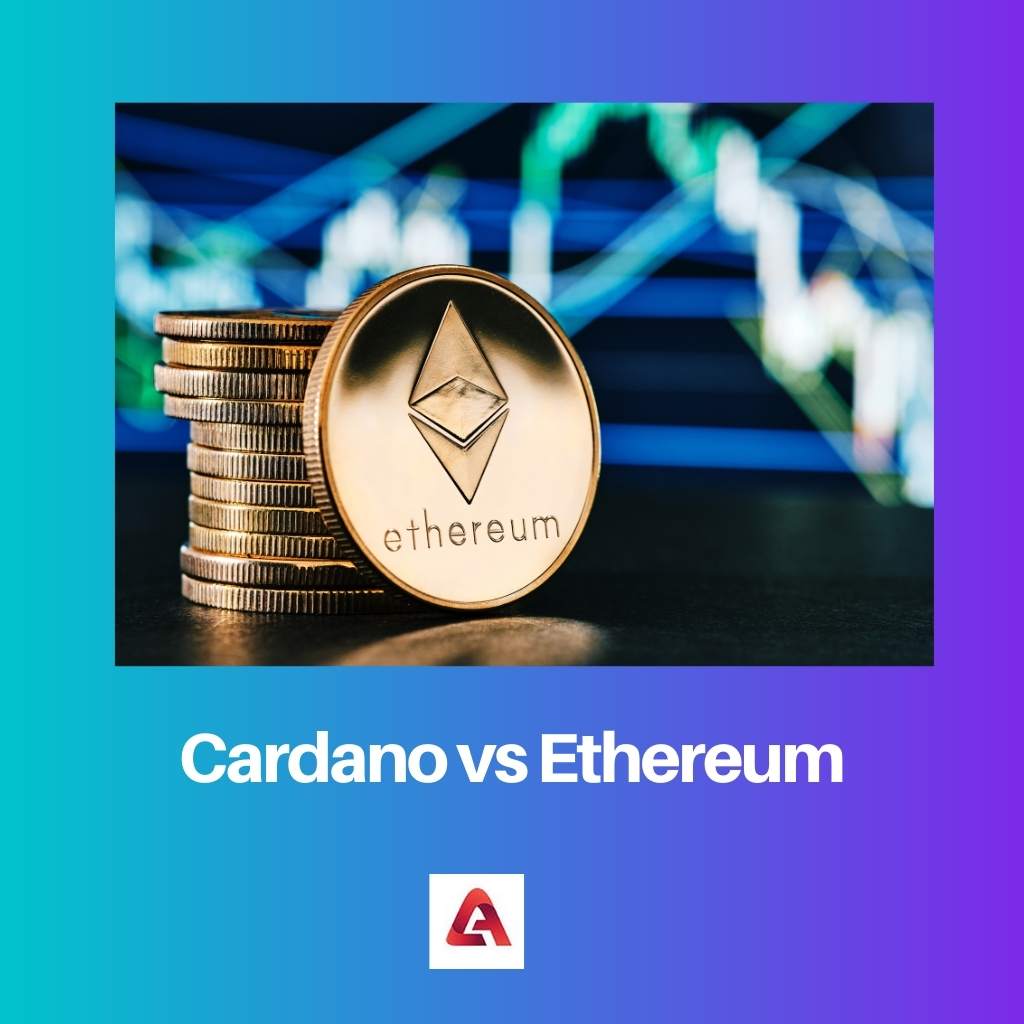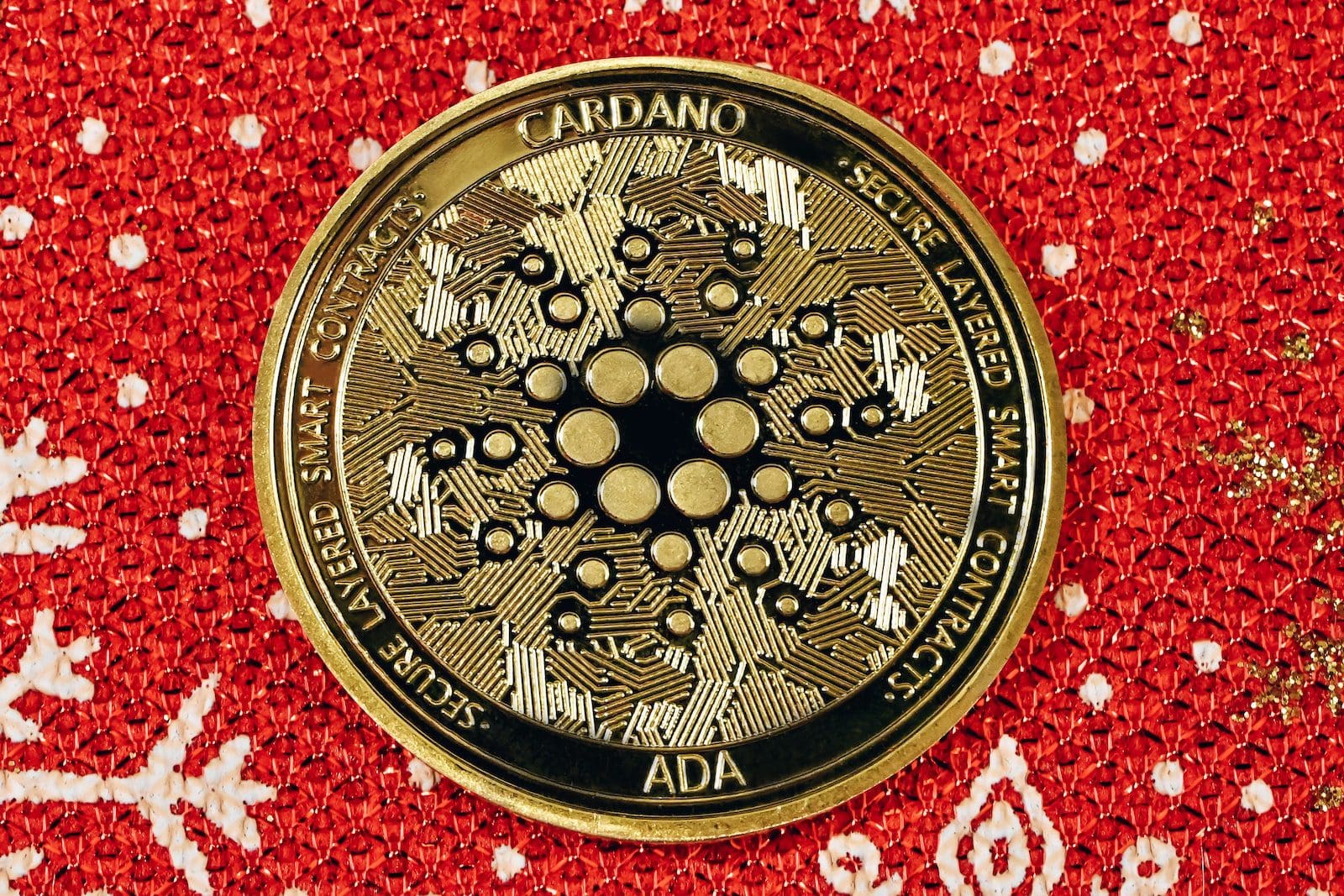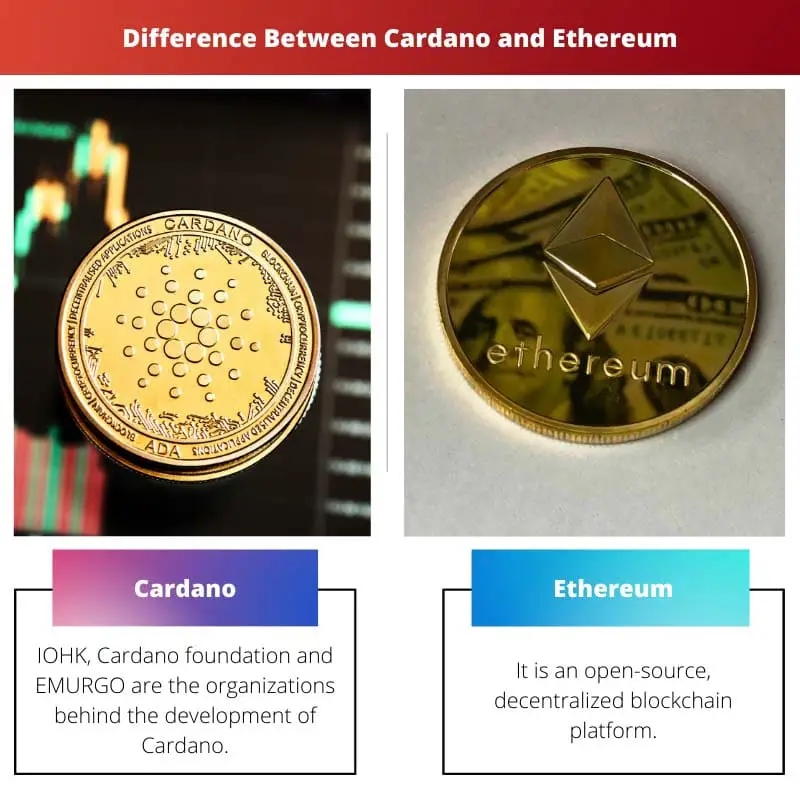Cardano aims for a secure and scalable blockchain through a layered architecture, employing the Ouroboros consensus algorithm. Ethereum, with its smart contract platform, focuses on decentralized applications and is transitioning to Ethereum 2.0 for improved scalability, utilizing the Proof-of-Stake mechanism.
Key Takeaways
- Cardano uses a proof-of-stake (PoS) consensus, while Ethereum currently uses a proof-of-work (PoW) consensus.
- Cardano is designed to be more scalable and energy-efficient than Ethereum.
- Cardano has a slower development cycle than Ethereum.
Cardano vs Ethereum
Cardano is a blockchain platform and cryptocurrency that was launched in 2017, and created by Input Output Hong Kong (IOHK), a blockchain company. Ethereum is a decentralized blockchain platform that enables developers to build and deploy decentralized applications (dApps) and smart contracts.

Cardano is the first one of the 3rd revolutions of the blockchain. It has two inbuilt layers. These two layers allow for deploying more sets of rules in the smart contracts.
Ethereum is a decentralized blockchain platform. It is open-source and comes with smart contract functionality. The native cryptocurrency on the platform for transactions is ether.
Comparison Table
| Feature | Cardano (ADA) | Ethereum (ETH) |
|---|---|---|
| Focus | Secure, scalable blockchain platform with research-driven development | Pioneering smart contracts platform with a vast ecosystem |
| Consensus Mechanism | Proof-of-Stake (Ouroboros) | Proof-of-Work (Transitioning to Proof-of-Stake) |
| Transaction Speed (Current) | ~250 TPS (Layer 1) | ~30 TPS (Layer 1) |
| Transaction Speed (Future) | Up to 2.5 million TPS (Hydra sidechain) | Up to 100,000 TPS (Ethereum 2.0) |
| Smart Contracts | Yes (Plutus language) | Yes (Solidity language) |
| DeFi Ecosystem | Growing (1,000+ dApps) | Established (3,000+ dApps) |
| Transaction Fees | More predictable, based on size and computation | Can be volatile, based on network congestion |
| Development Approach | Methodical, research-driven | Agile, first-mover advantage |
| Community & Adoption | Growing | Larger and more established |
What is Cardano?
Cardano is a third-generation blockchain platform designed to provide a more secure and scalable infrastructure for the development of decentralized applications (DApps) and smart contracts. Launched in 2017, Cardano aims to address the limitations of earlier blockchain technologies, such as Bitcoin and Ethereum, by combining innovative features and a scientific approach to development.
History and Development
Founded by Charles Hoskinson, one of the co-founders of Ethereum, Cardano’s development is led by Input Output Hong Kong (IOHK). The project’s development is guided by a rigorous research-driven approach, with a focus on peer-reviewed academic papers and collaboration with universities and research institutions.
Core Components of Cardano
Ouroboros Consensus Algorithm
Cardano utilizes the Ouroboros Proof-of-Stake (PoS) consensus algorithm, which ensures the security and sustainability of the network. Ouroboros divides time into epochs and slots, allowing for efficient block generation and validation without the energy-intensive mining process associated with Proof-of-Work (PoW) systems.
Ada Cryptocurrency
Ada is the native cryptocurrency of the Cardano platform, used for transactions, staking, and governance. It employs a treasury system, allowing the community to propose and vote on protocol upgrades or changes. This decentralized governance mechanism sets Cardano apart from other blockchain projects.
Cardano’s Multi-Layered Architecture
Settlement Layer (CSL)
The Settlement Layer handles the transfer of Ada between users and is responsible for maintaining the ledger. It ensures security and decentralization through the Ouroboros consensus algorithm.
Computation Layer (CCL)
The Computation Layer focuses on smart contract execution and decentralized application development. It aims to provide a secure and scalable environment for developers to build on the Cardano platform.
Key Features of Cardano
Scalability and Interoperability
Cardano is designed to scale horizontally, allowing for increased transaction throughput as the network grows. Additionally, the platform aims to facilitate interoperability with other blockchains, fostering a more connected and inclusive ecosystem.
Sustainability and Environmental Considerations
As a PoS-based blockchain, Cardano is recognized for its energy efficiency compared to PoW systems. The platform prioritizes sustainability and aims to minimize its environmental impact.
Formal Verification
Cardano places a strong emphasis on formal methods and verification during the development process. This approach enhances the security and reliability of smart contracts, reducing the risk of vulnerabilities and bugs.
Future Developments and Roadmap
Cardano’s development roadmap outlines plans for further protocol upgrades and enhancements. Upcoming features include the implementation of smart contract capabilities on the mainnet, improving the platform’s usability and expanding its use cases.

What is Ethereum?
Ethereum is a decentralized, open-source blockchain platform that enables the creation and execution of smart contracts and decentralized applications (DApps). Launched in 2015 by Vitalik Buterin, Ethereum has become one of the most prominent cryptocurrencies, offering a versatile and programmable blockchain infrastructure.
Architecture and Technology
1. Blockchain Structure
Ethereum employs a blockchain structure similar to Bitcoin, where transactions are grouped into blocks and added to the chain. However, it distinguishes itself by incorporating a more sophisticated scripting language.
2. Smart Contracts
One of Ethereum’s groundbreaking features is its ability to execute smart contracts. These self-executing contracts are written in Solidity, a Turing-complete programming language, allowing developers to create a wide range of decentralized applications.
Ether (ETH) – Native Cryptocurrency
1. Purpose and Usage
Ether (ETH) is the native cryptocurrency of the Ethereum platform. It serves various purposes, including facilitating transactions, compensating network participants for their computational efforts, and acting as collateral for decentralized finance (DeFi) applications.
2. Mining and Consensus Mechanism
Ethereum initially used a Proof-of-Work (PoW) consensus mechanism similar to Bitcoin. However, it is transitioning to Ethereum 2.0, which adopts Proof-of-Stake (PoS) to enhance scalability and reduce energy consumption.
Decentralized Applications (DApps)
1. Definition and Examples
Decentralized applications are software applications that operate on a decentralized network. Ethereum has facilitated the development of numerous DApps, ranging from decentralized finance (DeFi) platforms to gaming applications.
2. Decentralized Autonomous Organizations (DAOs)
Ethereum supports the creation of Decentralized Autonomous Organizations, allowing communities to govern themselves through smart contracts. DAOs enable transparent decision-making and fund management without central authority.
Challenges and Upgrades
1. Scalability Issues
As Ethereum gained popularity, scalability became a concern due to network congestion. Ethereum 2.0 aims to address this by introducing sharding and a transition to PoS, enhancing the network’s capacity.
2. Hard Forks and Upgrades
Ethereum has undergone several hard forks, including Byzantium, Constantinople, and Istanbul, to implement improvements and updates. These upgrades aim to enhance security, efficiency, and functionality.
Impact and Future Developments
1. Influence on Blockchain Industry
Ethereum’s introduction of smart contracts and DApps has had a profound impact on the blockchain industry, inspiring the development of other platforms.
2. Ethereum 2.0 and Beyond
The ongoing development of Ethereum 2.0 promises significant advancements, including improved scalability, security, and sustainability. The Ethereum community continues to play a vital role in shaping the platform’s future.

Main Differences Between Cardano and Ethereum
- Consensus Mechanism:
- Cardano: Utilizes the Ouroboros proof-of-stake (PoS) consensus algorithm, which aims to achieve security through a decentralized network of validators.
- Ethereum: Currently employs a proof-of-work (PoW) consensus mechanism (although it is transitioning to Ethereum 2.0, which will use PoS).
- Smart Contract Languages:
- Cardano: Supports smart contracts written in Plutus, a language designed with formal methods to enhance security.
- Ethereum: Primarily uses Solidity for smart contracts, which has been associated with security vulnerabilities in the past.
- Development Approach:
- Cardano: Emphasizes a research-driven and academically rigorous approach, focusing on formal verification and peer-reviewed research to enhance security and reliability.
- Ethereum: Historically adopted a more iterative and experimental approach, with updates and improvements implemented over time.
- Scalability:
- Cardano: Addresses scalability concerns through a layered architecture, separating the settlement and computation layers, aiming to improve efficiency.
- Ethereum: Has faced scalability challenges, especially with the congestion and high gas fees on the Ethereum 1.0 network. Ethereum 2.0 aims to address these issues through PoS and other improvements.
- Governance Model:
- Cardano: Employs a decentralized governance model with a treasury system, allowing ADA holders to vote on proposed protocol changes and fund development projects.
- Ethereum: Has been transitioning towards a more decentralized governance model, with Ethereum Improvement Proposals (EIPs) and community discussions playing a role in decision-making.
- Interoperability:
- Cardano: Focuses on cross-chain interoperability, aiming to enable seamless communication and transactions between different blockchain networks.
- Ethereum: Interoperability solutions are being explored and developed, but the Ethereum network has been more standalone in its initial design.
- Community and Adoption:
- Cardano: Has gained traction for its academic approach and focus on security. Adoption has been growing, with projects building on the Cardano blockchain.
- Ethereum: Has a large and established community with widespread adoption and a significant number of decentralized applications (DApps) and tokens built on its platform.
- Token Standards:
- Cardano: Introduced the native token standard called “native tokens” to support multi-asset functionality without the need for smart contracts.
- Ethereum: Utilizes ERC-20 and ERC-721 standards for fungible and non-fungible tokens, respectively.


The introduction of Atala PRISM, Atala SCAN, and Atala Trace by Cardano highlights its broader strategic vision and focus on real-world applications.
Indeed, these products demonstrate Cardano’s commitment to providing practical and meaningful solutions for various industries.
The commitment to peer-reviewed scientific research in Cardano’s development process is commendable. It reflects a rigorous approach to innovation and improvement.
Absolutely, Cardano’s emphasis on scientific research sets it apart in the blockchain landscape.
Interesting article. It is clear that blockchains like Cardano and Ethereum are the future of technology and finance.
The detailed comparison of Cardano and Ethereum is very helpful. It’s important to understand their unique features.
Indeed, this comparison offers a lot of valuable insights. Both platforms have their strengths and weaknesses.
The article offers a thorough examination of Cardano and Ethereum, providing a nuanced understanding of their key features and principles.
The organizational differences between Cardano and Ethereum are quite significant. It’s essential to know how these platforms are managed and maintained.
The comparison table is very informative. It helps in understanding the key features and characteristics of Cardano and Ethereum.
Absolutely, the governance and maintenance structures of these platforms play a crucial role in their long-term success.
The detailed comparison of Cardano and Ethereum underscores the complexity and diversity of the blockchain landscape. It’s an important reference for industry professionals and enthusiasts.
Absolutely, the dynamic nature of blockchain platforms requires careful study and analysis. This article provides a valuable resource for understanding Cardano and Ethereum.
The article provides useful insights into the unique qualities of Cardano and Ethereum. This level of analysis is crucial for making informed decisions in the cryptocurrency space.
Definitely, understanding the main differences between Cardano and Ethereum helps in evaluating their potential applications and benefits.
Understanding the main differences between Cardano and Ethereum is crucial. It allows for an informed assessment of their respective strengths and capabilities.
The comparison of native currencies and organizational structures is particularly illuminating. It sheds light on the distinct characteristics of Cardano and Ethereum.
Absolutely, this comparison provides valuable insights for individuals and enterprises looking to engage with blockchain technology.
The development cycle of Cardano and Ethereum is an interesting point of comparison. Cardano’s focus on scalability and efficiency is quite impressive.
Agreed. I believe the slower development cycle of Cardano reflects a thorough and careful approach to innovation.
This article offers a comprehensive understanding of the differences between Cardano and Ethereum. The comparison of native currencies is particularly enlightening.